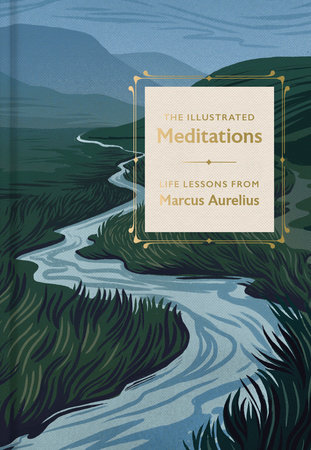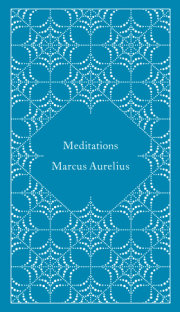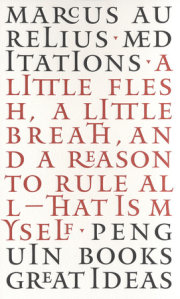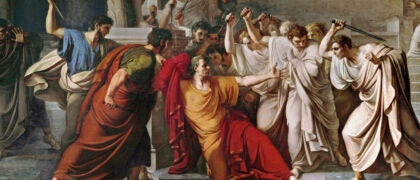IntroductionTwice in the
Meditations Marcus Aurelius, emperor of Rome from AD 161 to 180, deploys the metaphor of the dyeing of cloth. In the first of these passages (5.16), he tells himself to “dye the soul with a continuous series of thoughts,” the principles that will lead him toward a good life. In the second, he refers to the fact that, in his role as emperor or “Caesar,” he had the exclusive right to wear a robe dyed entirely purple, essentially a royal accoutrement. “Take care to not become a Caesar,” he instructs himself, inventing a new Greek word (he writes in Greek, though Latin was his native language). Do not be “dyed with that dye; it can happen.” He urges himself to follow the model of Antoninus, his adoptive father and predecessor as ruler, whom he considers a model of monarchic virtue (6.30; see page 118).
Here in these two metaphorical uses of dyeing, we see two sides of the man who today is often called by his first name, Marcus: his public role, that of ruler of a great part of the globe, and the innermost self he sought to improve by “dyeing” it with the ideas he expresses in
Meditations. His compilation of those ideas was never intended for publication; it served instead as a purely personal set of self-exhortations. Whenever he uses the pronoun “you,” or puts verbs into a second-person singular form, he is talking to himself, not to an imagined reader. Indeed the title of the work is sometimes given as To Himself, a more accurate description of its contents, perhaps, than
Meditations, which became affixed to it only in the 17th century.
Dyeing in the ancient world required repeated dipping of cloth into dye, and
Meditations is filled with repetition. Marcus comes back again and again to its central precepts, framing them in new ways or examining them from new angles. “Your habitual thoughts will shape the character of your mind,” he tells himself in the first of his dyeing analogies, providing a good explanation of the goal of his work. His “notebooks,” as the twelve subdivisions of the work are sometimes termed, were his way of rehearsing the principles of his philosophical system. That system, inherited from the Greeks of the 3rd century BC by way of Roman intermediaries, is called Stoicism, after the Painted Stoa, a colonnade in Athens where its founding father, Zeno of Citium, used to instruct his disciples.
In his notebooks Marcus allows himself to roam freely among a wide range of topics, as though addressing day by day whatever was most on his mind. The current volume selects from this sometimes confusing jumble a small set of crucial entries, then groups them into eight thematically organized chapters. Readers will find an inviting, and beautifully illustrated, pathway into the
Meditations, arranged so as to give an overview of Marcus’s system of belief. That system, Stoic philosophy, was already centuries old when he wrote and is now many times older; yet, as this collection demonstrates, the principles Marcus took from it are still as potent as ever, teaching us how to
live and not merely
to be.
The tenets of Marcus’s Stoicism will be explored, one by one, in the introductions to the chapters that follow, but a broad outline can be given here. For the Stoics, the good life is a life in harmony with Nature, for Nature is thoroughly rational and benign, the expression of the rational force that controls the larger cosmos. That force can be conceived of as the gods or as God, as Mind, or as Logos, a multilayered Greek word that includes ideas of reason, speech, and thought. Our human capacity for reason has been bestowed by this benevolent force, bringing us closer to divinity than any other species. To follow its promptings unswervingly would make us even more godlike, as we are meant to be.
What does our reason prompt us to do, as we go about a largely unreasonable world? Above all, to act virtuously, for virtue is in accord with the divine plan for the cosmos. We are social creatures who depend on bonds of fellowship for survival, since we lack the assets—claws, fangs, tough hides, and the like—that protect other species. Our uniquely social existence requires that we treat one another well, so virtuous behavior is in accord with Mind and with Nature. We belong to a human community, so everything that benefits that community also benefits us. False opinions, however, lead us to pursue private objectives—pleasure, or wealth, or fame—as sources of happiness. Stoics consider such things “indifferent” in that they conduce neither to virtue nor vice, and therefore do not affect our happiness in any real sense.
Along with the problem of false opinions, Stoic practice also means coping with the phantasiai or “impressions” that are constantly streaming into our souls. Sights or smells may arouse our desire for pleasure, things we hear—for example, insults—may stimulate our anger, or pain felt by our nervous system may provoke fear. These emotional responses can overwhelm our rational minds, if we allow them to do so. We must instead put our reactions on hold and ask the only question that matters: “Will this hinder my capacity for reason and virtue?” If the answer is no, we’d have no reason to dread even attacks of wild beasts or slanders hurled at us by an entire nation, Marcus maintains. Such apparently miserable experiences are actually indifferent, in that they do not make us any more or less virtuous.
There’s far more to orthodox Stoicism than what has been summarized here, but these are the themes that Marcus is most concerned with in
Meditations, the rosary beads of his mind. He recurs to them over and over, as though determined not to let go of the insights he has gained. The earnestness of his project is what makes it compelling; his writing takes energy from the gravity of his quest. There are few moments of levity in
Meditations, and nothing ironic or insincere. Marcus never hides behind an authorial mask, as other ancient philosophic writers, Plato and Seneca among them, often do. He is writing only for and to himself, a circumstance that makes his prose uniquely authentic and genuine.
How did such a private text, in essence a personal journal, come to be preserved such that we can read it today? That question, like many concerning
Meditations, is difficult to answer. We don’t know for certain when Marcus began writing the work or when he stopped. Two of the twelve notebooks, numbers 2 and 3, bear headings indicating the places they were composed, in both cases military outposts on Rome’s northern frontier. Marcus was on campaign in this region during the early 170s, fighting Germanic tribes that were making incursions, so it can be assumed he wrote those parts of
Meditations at that time. He was still on campaign in the north when he died in AD 180; presumably he had the notebooks with him and some quick-witted underling ensured they were not discarded.
The idea that Marcus was engaged in a grueling series of wars, designed to fend off threats to Rome’s borders, when he wrote
Meditations has added to the stature of the work and, for some readers, augmented its power to inspire. Two widely viewed American movies,
The Fall of the Roman Empire (1964) and
Gladiator (2000), portray Marcus as a stolid, stalwart commander, defending the empire despite the toll of advancing age. Both movies have also highlighted, for readers of
Meditations, the pathos of Marcus’s position at the edge of a historical precipice. He was the last of the “five good emperors,” a series that had begun more than eight decades before his death, and his successor, his debauched son Commodus, brought that long era of
stability to an end.
A weary man in his fifties, a sage who turns warrior out of a sense of duty, all the while knowing his heir may undo all he has done—it’s a compelling portrait, at least in the way Hollywood has constructed it. But we do not need a biography to gain inspiration from
Meditations; its teachings transcend time and place. Indeed, if the work had been handed down without the name of its author, only a very few passages, such as the praise of Antoninus, would allow us to guess that the wealthiest, most powerful man in the world had composed it.
Few of us need worry about becoming “Caesarized,” but all of us face, every day, challenges to the qualities that make us fully human: our rationality, our benevolence, our capacity for virtuous action. To meet those challenges requires constant effort, a dyeing of the mind by repeated dipping. The task is never finished, but the rewards are enormous and within the reach of every spiritual striver. If Marcus could succeed—and it seems, to judge by
Meditations, that he did—then so can we.
Copyright © 2025 by Marcus Aurelius; Illustrated by Joanna Lisoweic; Introduction by James Romm. All rights reserved. No part of this excerpt may be reproduced or reprinted without permission in writing from the publisher.































